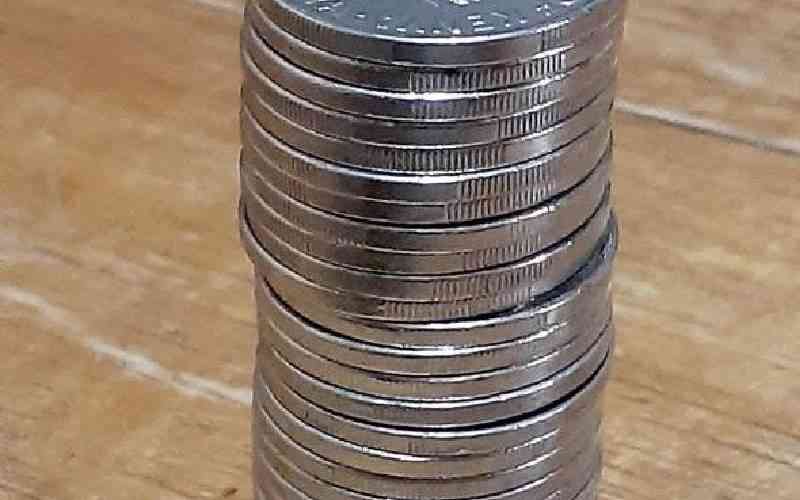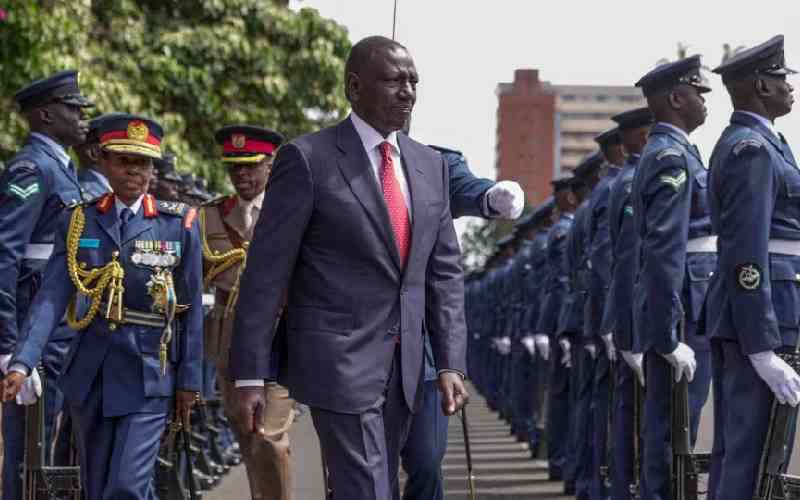
The Government last week confirmed it had begun preparing to issue a second Eurobond. This news, however, comes amid long-standing controversy on the country’s debut issue in 2014.
Kenya’s first Eurobond was a complex web of transactions that even auditors and economists have struggled to follow.
Expenditure of the proceeds of the borrowing has created a huge rift among ordinary Kenyans, and provided the Opposition with ready ammunition.
Worse still, Government officials are worried that the division could potentially impact investor appetite when the country issues its second bond in the international markets.
“It is affecting our risk profile, which would mean high interest rates,” said Treasury Principal Secretary Kamau Thugge.
Today, Business Beat presents its findings after digging into the Government’s books to track the funds from the point investors from across the world bought into the offer, to the disbursements to State ministries, departments and agencies.
WHERE IT STARTED
After a successful ‘beauty parade’ in the US two years ago, Kenya got overwhelming responses from international markets.
Treasury Cabinet Secretary Henry Rotich and his team had pulled out all the stops to position Kenya as the place for investors looking to put their money in Africa.
The marketing road shows paid off handsomely, with the cash call oversubscribed three-fold as investors raced to get a piece of the action – they were willing to lend Kenya Sh250 billion from an initial target of Sh75 billion.
The prospectus given to potential investors showed the money was being raised for “general budget support, including infrastructure”.
The funds were also to be used to retire a syndicated loan of $600 million (Sh53.2 billion at exchange rates back then), plus accrued interest of $4.6 million (Sh400 million).
Two years later, the country is looking at travelling the same path to raise money in a similar fashion, even as it becomes clear that Kenyans may never know exactly which projects were funded using the billions of shillings raised in the first Eurobond.
Business Beat has followed the money trail of the first loan, looking through bank statements, swift messages, and correspondence between various actors in the transactions –from the Central Bank of Kenya (CBK) and the Treasury to the offshore accounts at JP Morgan Chase Bank and Citibank in New York.
Stay informed. Subscribe to our newsletter
Kenya opened an offshore account at JP Morgan Chase Bank, which acted as the special collecting account for the money from the lead managers.
The Government had four lead managers – JP Morgan Securities Plc, Barclays Bank Plc, QN Bank Capital Llc and Standard Bank Plc – who received the money directly from investors on behalf of the Government.
The lead managers then transferred the money raised to the Government’s sovereign bond account at JP Morgan Chase Bank in the US through Swift payments. This was a dollar account, so all the money was received in dollars. In total, $1.9 billion (Sh176.2 billion) was received in the first part of the bond payments.
After this, the transactions become more complicated.
From this offshore account, Government records suggest that the CBK opened a special sovereign bond account that was operated in shillings and held in Nairobi. This is the account that was to receive the money from abroad.
The special sovereign bond account number held at the CBK was 1000212764.
However, the first transaction of Sh34.6 billion was not deposited into this account. Instead, the money was send directly from the offshore account to the Exchequer account.
Dr Thugge, who provided bank statements to back up his explanations, said the Government used this amount to meet some pending bills from the previous financial year – 2013-14.
“We had outstanding bills to settle, and did so immediately the funds became available. It is normal,” he told reporters last week.
But the PS could not give details of the urgent bills the Government had to settle three days into the financial year.
Another Sh53.2 billion was used to pay off the syndicated loan that had matured. This amount was sent directly in dollars to avoid foreign exchange losses.
Opening balance
A certified statement from the CBK shows that the special Eurobond account had an opening balance of Sh88.4 billion on July 1, 2014 – the first day of the financial year.
The CBK account does not capture the Sh34.6 billion, despite the Treasury insisting all the transactions were treated the same way.
The CKB had an account at the Federal Bank in the US, which received the funds from JP Morgan in dollars, and paid the equivalent amount to the Treasury in a transaction that mirrors buying dollars from the Government and paying for them in shillings.
Thugge said the Government treated all the proceeds from the two issues the same way – receiving the money into one collecting account, selling the dollars to the Central Bank of Kenya, which was crediting the equivalent to a special Eurobond account in the Consolidated Fund (National Exchequer).
It is from this account that money was dished out to various ministries.
“All the transactions were done the same way. If someone is questioning, then you should question all of them or none at all,” Thugge said.
Thugge added that more than 70 per cent of the money that remained after the Government paid off the syndicated loan was used to fund the development budget.
But the Treasury does not have a list of the development projects that the money was used on.
The Sh88.4 billion was withdrawn in at least eight different transactions, and deposited to the Exchequer account, with the approval of Controller of Budget Agnes Odhiambo. Ministries, departments and State agencies receive their funds from the Exchequer account.
The first withdrawal of Sh25 billion happened on a Monday, one week after the funds hit the account.
The transfer was authorised by a letter from Thugge, and left the account with Sh63.4 billion. The CBK must receive an official request from the Treasury before making any transfers.
The Treasury put in a request for another Sh25 billion the same week, and this was withdrawn on Friday, four days after the first withdrawal.
According to a CBK statement, the account had a balance of Sh38.4 billion on September 19, 2014.
There was no activity on the account for 40 days until the second last day of October, when Sh15 billion was withdrawn from the account, leaving it with Sh23.4 billion.
Renewed appetite
Before the Government could exhaust this amount, appetite for the second tranche of the loan was already building. It is at this point that it went back to the international markets for a top-up.
A second offshore account was opened with Citibank in New York on November 27, 2014 to receive the proceeds from the tap sale.
On December 3, 2014, the account was credited with $815.4 million, which translated to Sh73.8 billion after CBK converted the dollars.
The money was received in the same Eurobond account in Nairobi a week before Christmas in 2014. By the end of the year, the CBK account held Sh97.2 billion.
Three weeks into 2015, on January 21, Treasury withdrew another Sh25 billion. About two months later, the Treasury asked for another Sh25 billion. This was the fourth Sh25 billion withdrawal, and the fifth withdrawal.
Documents show that the remaining Sh47.2 billion was wired in two transactions on June 2 and July 1 of Sh30 billion and Sh17.2 billion, respectively. As at July 1 last year, the Eurobond account at the CBK had a zero balance.
It is after money is wired out of this special account to various ministries that the trail goes cold.
The Treasury gave a list of 14 ministries, departments and agencies that received the disbursements.
The State Department for Infrastructure took the lion’s share of the funds, receiving Sh64 billion.
Other departments that received a share of the money include Planning (Sh44.5 billion), Science and Technology (Sh8.9 billion), Commerce and Tourism (Sh2.6 billion), and Livestock (Sh2.5 billion).
The Treasury, which backtracked on an earlier promise to provide a list of projects, now maintains that it is difficult for the recipients to differentiate money they received from the Eurobond from what came from other sources.
“If you work and receive a salary, and at the same time you are a landlord – if you receive the money in one account and want to spend it, it is not possible to tell which shilling is from rent and which one is from your salary,” Thugge said.
The explanation comes at a time when the Auditor General is yet to clear the Government on the money trail.
“Investigations into the receipts, accounting and use of funds related to the Sovereign/Euro Bond are still ongoing and the accuracy of the net proceeds of Sh215,469,626,035.75 is yet to be ascertained,” said Auditor General Edward Ouko in his latest report.
Mr Ouko singled out the Ministry of Water and Irrigation, which was said to have received Sh11.2 billion. He said the officials failed to show any documentation of receipt and expenditure.
“The management has not provided any list of project(s) that were funded by the Eurobond proceeds. In the circumstances, it has not been possible to confirm how the Eurobond funds were utilised,” the report notes.
Ouko is yet to make public the findings of his investigators, who were sent abroad to verify the claims on the proceeds.
pwafula@standardmedia.co.ke
 The Standard Group Plc is a
multi-media organization with investments in media platforms spanning newspaper
print operations, television, radio broadcasting, digital and online services. The
Standard Group is recognized as a leading multi-media house in Kenya with a key
influence in matters of national and international interest.
The Standard Group Plc is a
multi-media organization with investments in media platforms spanning newspaper
print operations, television, radio broadcasting, digital and online services. The
Standard Group is recognized as a leading multi-media house in Kenya with a key
influence in matters of national and international interest.
 The Standard Group Plc is a
multi-media organization with investments in media platforms spanning newspaper
print operations, television, radio broadcasting, digital and online services. The
Standard Group is recognized as a leading multi-media house in Kenya with a key
influence in matters of national and international interest.
The Standard Group Plc is a
multi-media organization with investments in media platforms spanning newspaper
print operations, television, radio broadcasting, digital and online services. The
Standard Group is recognized as a leading multi-media house in Kenya with a key
influence in matters of national and international interest.






